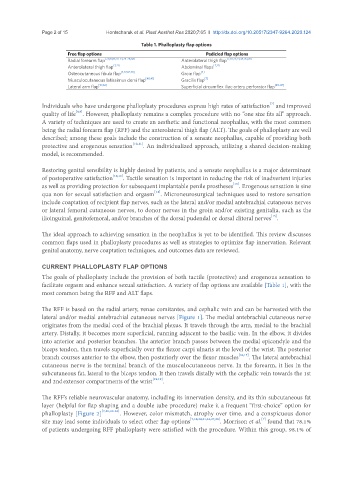Page 765 - Read Online
P. 765
Page 2 of 15 Hontscharuk et al. Plast Aesthet Res 2020;7:65 I http://dx.doi.org/10.20517/2347-9264.2020.124
Table 1. Phalloplasty flap options
Free flap options Pedicled flap options
Radial forearm flap [7,8,10,11,20-23,24-28,68] Anterolateral thigh flap [7,20,21,23,34,35,68]
Anterolateral thigh flap [7,21] Abdominal flaps [7,21]
Osteocutaneous fibula flap [7,27,42,70] Groin flap [7]
Musculocutaneous latissimus dorsi flap [40,41] Gracilis flap [7]
Lateral arm flap [10,66] Superficial circumflex iliac artery perforator flap [45-47]
[7]
Individuals who have undergone phalloplasty procedures express high rates of satisfaction and improved
[8,9]
quality of life . However, phalloplasty remains a complex procedure with no “one size fits all” approach.
A variety of techniques are used to create an aesthetic and functional neophallus, with the most common
being the radial forearm flap (RFF) and the anterolateral thigh flap (ALT). The goals of phalloplasty are well
described; among these goals include the construction of a sensate neophallus, capable of providing both
protective and erogenous sensation [10,11] . An individualized approach, utilizing a shared decision-making
model, is recommended.
Restoring genital sensibility is highly desired by patients, and a sensate neophallus is a major determinant
of postoperative satisfaction [10,12] . Tactile sensation is important in reducing the risk of inadvertent injuries
[13]
as well as providing protection for subsequent implantable penile prostheses . Erogenous sensation is sine
qua non for sexual satisfaction and orgasm . Microneurosurgical techniques used to restore sensation
[14]
include coaptation of recipient flap nerves, such as the lateral and/or medial antebrachial cutaneous nerves
or lateral femoral cutaneous nerves, to donor nerves in the groin and/or existing genitalia, such as the
[15]
ilioinguinal, genitofemoral, and/or branches of the dorsal pudendal or dorsal clitoral nerves .
The ideal approach to achieving sensation in the neophallus is yet to be identified. This review discusses
common flaps used in phalloplasty procedures as well as strategies to optimize flap innervation. Relevant
genital anatomy, nerve coaptation techniques, and outcomes data are reviewed.
CURRENT PHALLOPLASTY FLAP OPTIONS
The goals of phalloplasty include the provision of both tactile (protective) and erogenous sensation to
facilitate orgasm and enhance sexual satisfaction. A variety of flap options are available [Table 1], with the
most common being the RFF and ALT flaps.
The RFF is based on the radial artery, venae comitantes, and cephalic vein and can be harvested with the
lateral and/or medial antebrachial cutaneous nerves [Figure 1]. The medial antebrachial cutaneous nerve
originates from the medial cord of the brachial plexus. It travels through the arm, medial to the brachial
artery. Distally, it becomes more superficial, running adjacent to the basilic vein. In the elbow, it divides
into anterior and posterior branches. The anterior branch passes between the medial epicondyle and the
biceps tendon, then travels superficially over the flexor carpi ulnaris at the level of the wrist. The posterior
branch courses anterior to the elbow, then posteriorly over the flexor muscles [16,17] . The lateral antebrachial
cutaneous nerve is the terminal branch of the musculocutaneous nerve. In the forearm, it lies in the
subcutaneous fat, lateral to the biceps tendon. It then travels distally with the cephalic vein towards the 1st
and 2ndextensor compartments of the wrist [18,19] .
The RFF’s reliable neurovascular anatomy, including its innervation density, and its thin subcutaneous fat
layer (helpful for flap shaping and a double tube procedure) make it a frequent “first-choice” option for
phalloplasty [Figure 2] [7,10,20-26] . However, color mismatch, atrophy over time, and a conspicuous donor
[7]
site may lead some individuals to select other flap options [7,10,20,21,24,27,28] . Morrison et al. found that 78.1%
of patients undergoing RFF phalloplasty were satisfied with the procedure. Within this group, 98.1% of

